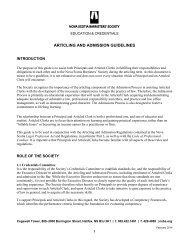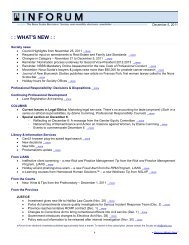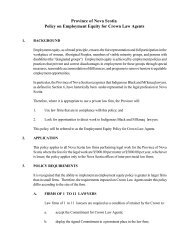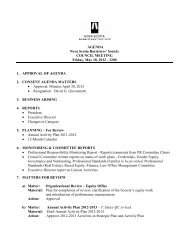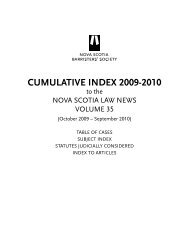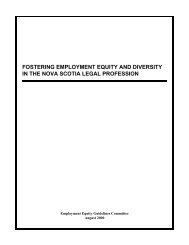SR Vol 24 No 5, October 2006 - Nova Scotia Barristers' Society
SR Vol 24 No 5, October 2006 - Nova Scotia Barristers' Society
SR Vol 24 No 5, October 2006 - Nova Scotia Barristers' Society
- No tags were found...
Create successful ePaper yourself
Turn your PDF publications into a flip-book with our unique Google optimized e-Paper software.
treatment is discriminatory. It is discriminatory because it does notcorrespond to the actual needs and circumstances of injured workerssuffering from chronic pain, who are deprived of any individualassessment of their needs and circumstances. Such workers are, instead,subject to uniform, limited benefits based on their presumedcharacteristics as a group.”Chronic pain is a thorny issue and at the heart of <strong>No</strong>va <strong>Scotia</strong>’s cap.Do caps work? According to George Jordan, who was appointed inApril 2003 as the province’s first consumer advocate on auto insurance,(a position he held for two years) the caps are working well forinsurance companies but not for people with chronic pain.The other thorny issue at the heart of the debate is profit. Opponentsof the cap are quick to point out that insurance companies foughtfor restrictions on auto injury payments claiming that their ability tomake a profit was seriously affected by escalating payouts. That claimdid not seem to hold up over time. As Liberal leader Francis MacKenzieproclaimed during last summer’s election, “The Canadian (insurance)industry has posted recordedprofits of $16 billion in the last threeyears; $2.3 billion in the year theconservative government took awaythe rights of many <strong>No</strong>va <strong>Scotia</strong>ns tofair compensation.”Linked to the profit question wasa promise, albeit an ephemeralone, that premiums would declineas costs to insurance companiesdropped. It is difficult to determineif this has happened (to any extent)for a number of reasons, including the fact that governments oftendid more than introduce a cap or deductible in an effort to combatescalating prices. Clearly though, if premiums are down, they arenot down significantly and in no way mirror the significant profitsrecorded by the insurance industry. According to the Financial ServicesCommission of Ontario, for example, in the first quarter ofthis year the average rate for automobile coverage, where there was achange, dipped by only 0.71 per cent.<strong>No</strong>va <strong>Scotia</strong> is not alone in its journey to court, or in its attempts tolimit – in some fashion – auto accident injury claims. Most provincesnow have some form of restriction for compensation in place:PEI and New Brunswick have a cap equivalent to <strong>No</strong>va <strong>Scotia</strong>’s,while Alberta’s cap for minor injuries is $4000. Caps are challenged,and criticized, primarily because they limit payouts without takinginto consideration individual circumstances.Newfoundland and Labrador swerved to avoid this controversialapproach by implementing a $2500 deductible, which reduces everypain and suffering payment, regardless of type or extent of injury,by this set amount. For someone awarded $2000 in damages, thedeductible would effectively wipe out their award. For someoneawarded $70,000 in damages, however, the deductible would onlyreduce their payout to $67,500.It may sound like a reasonable approach, but George Sweeney, OppositionCritic for Government Services in Newfoundland andLabrador, contends the deductible is not working. “It is evidentthat government’s $2500 deductible scheme has not provided the“Clearly though, if premiumsare down, they are not downsignificantly and in no waymirror the significant profitsrecorded by the insuranceindustry. ”necessary limit on claims paid by insurers in the province,” he says.“It is time for government to reevaluate its decision to reject the recommendationof the Public Utilities Board to up the deductible to$10,000 or implement a $2500 cap as used in other provinces.”Veering even further afield in an effort to grapple with auto insurancecosts is Ontario, which has introduced both a threshold and a$30,000 deductible. According to an Ontario Ministry of Financewhite paper, the threshold requires that a victim’s injuries exceed acertain level before they can sue for pain and suffering. The “verbalthreshold,” as it is called in the province, necessitates that a personhas sustained a “permanent serious disfigurement” or a “permanentserious impairment of an important physical, mental or psychologicalfunction”. Once the threshold is met, $30,000 is then deductedfrom any payout.“What is being done on the backs of Ontario motorists is an outrage….The simple fact is that Ontarians are being milked to feed the insuranceindustry’s greed for record profits,”says Russ Howe, immediate pastpresident of the Ontario Trial LawyersAssociation.At the other end of the spectrumis B.C., which has a public autoinsurance system and where thereis no legislated cap, deductible orthreshold. Payment is determinedby negotiation or in court.<strong>No</strong>va <strong>Scotia</strong>’s cap is now beingchallenged in court. A similar legal challenge is under way in Alberta,and New Brunswick lawyers are poised to take legal action.It seems likely Ontario will follow suit and test the legality of thethreshold and deductible in court.One of the people looking forward to seeing the issue tested in thecourts is George Jordan. It is, he believes, the only way the controversywill ultimately be resolved. At the very least, an uneasy trucemay be reached.<strong>October</strong> <strong>2006</strong> 15



